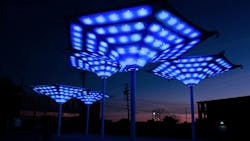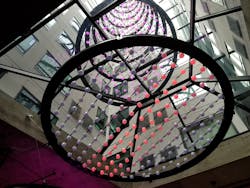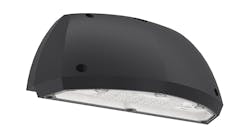Several years ago, I was involved in a startup that combined lighting and what is now called “placemaking.” My partner and I had both been involved in the early days of New Urbanism (he more than I) and were familiar with how the movement had evolved into a somewhat grassroots placemaking initiative, as exemplified by groups like the Project for Public Spaces1. The reason we were most interested in doing this was that while community groups, architects, and developers were all doing really interesting work making beautiful places, almost none of them focused on what happens at night in vital city centers. We knew about Leni Schwendinger, a world-class lighting designer who with her many initiatives is probably the leading practitioner of nighttime design today2, but on the whole many places were designed for the vibrancy of daylight experience.
Two of the leading practitioners of digital placemaking, Robb Pope of Digital Ambiance and Nick Moser of One Hat One Hand, will be on hand to present their work and ideas at Strategies in Light on Aug. 25 at 1:30 PM CDT. I recently spoke with Robb to understand his perspective and approach on this global phenomenon.
Clifton Stanley Lemon: Robb, can you tell me, what is “digital placemaking” exactly?
Robb Pope: I think that placemaking is fundamentally the art of branding or developing an identity for physical-spaces architecture. The kind of placemaking that we practice is digital placemaking, which uses technology to create spectacle and identity around architecture.
CL: How did you get into this line of business?
RP: I originally started doing live video art back in college and that led me into the concert touring industry back in the early 2000s. My career kind of blossomed from there, but eventually everybody who does concert touring burns out, and I made the decision to come off the road in 2009. I ended up in the Bay Area because out of all my travels, it was the place that I vibed with the most. At that time, it was very much a rich artistic environment and a hotbed of New Media Arts.
CL: If you’re like me, you ended up in the Bay Area because it’s the place where people who don’t fit in anywhere else come, right? When I was a kid growing up in Southern California, I was obsessed with all the psychedelic art and music happening up here — the acid trips, the Merry Pranksters, the Happenings, and the multimedia rock concerts. So your first real experience with light was in entertainment and people having ecstatic experiences in a multimedia environment, right?
RP: I really see all that as a progenitor to what we do now. Back then, lighting consisted of dimmers, incandescent bulbs, and PAR cans with gels. There was this guy, Joshua White, who was messing around with very analog forms of video — using oil and water and food colors to create hand-manipulated “video performances” for Janis Joplin and Jimi Hendrix. He’s kind of the godfather of live performance video art! He eventually had a career in advertising and now he’s back at it, he’s doing New Media Arts again. I host a podcast called the Luminous Arts and recently did an episode with him9.
CL: How much of what you do relies on solid-state lighting?
RP: LEDs are just one tool in the toolbox, and there are many available to choose from — video projection, lasers, advanced sensors, kinetics. It could be any number of technologies woven together to make a piece of architecture more memorable to the public. To me, digital placemaking is the art of fitting a canvas onto a piece of architecture — not all mediums fit on all architecture. A big part of it is determining what would be appropriate for different types of buildings or applications.
CL: You used the term “spectacle” to describe what you do. This is not a term that an architect or design person would typically use, as building professionals are so concerned with energy efficiency, problem solving, and health and wellbeing. Can you explain what you mean?
RP: By spectacle, I mean something that grabs the imagination, something that’s memorable — that’s what placemaking is all about. It’s attracting attention to a particular piece of architecture, which could be particularly important in a public space — because without any kind of flair or creative element, you end up with like the Brutalist architecture of the 1960s and 70s, right? Today, pairing really innovative forms of architecture, like parametric designs generated by algorithms with New Media Art technology that is woven into the fabric of the architecture, produces some incredible results.
CL: I’ve always expected designers to do much more creative things with all the new technology. At first when it came out, it seemed like all anyone wanted to do was put rainbow colors on buildings — which reminded me of those cheesy aluminum Christmas trees with the slowly rotating color-gel wheels from the 1960s.
RP: It comes down to the programming element. In my mind, that’s really the most important part of the whole equation. We probably have all the technology we need, and can combine technologies in endless ways, but it’s the creativity of how you do it that matters most.
CL: I understand your reaction to Brutalism, and in recent years many people have taken to saying that the style is back. Wouldn’t some of these buildings present sort of a “blank canvas” to you, kind of like you were a graffiti artist?
RP: I don’t mean to knock on that particular style unfairly. It is definitely a school of thought in architecture. I just think the time is changing. And today’s paradigm has a more flamboyant feel. I personally like a more organic feel in architecture, integrating nature into the designs. Back to your comments about integrating New Media Art into existing structures — that’s always a tricky thing. We try to avoid that because it can be very difficult to integrate after construction is completed. You can do it if you’re doing a complete retrofit, but just slapping LEDs on the surface of a building doesn’t usually turn out well. The magic happens when you work with the architect to integrate this technology from the beginning, and you have architecture that’s designed with elements meant to accept this kind of technology.
CL: That’s exciting. I’ve always wondered what would it be like to have an architect who comes to you not saying, “Here’s a building, put some lighting, some decoration on it” but instead puts lighting at the very top of the list of considerations for designing the building. Do you feel you’re actually a partner in some of these projects because it’s a combination of the structure and the light that will go on it?
RP: That’s the narrative that we encourage. Architects are some of our main clients — lighting designers, too. In our conversations, we push very hard to work with the team early in the design process and collaboratively. We think of our clients as equal partners in the design narrative. We’ll get a call from an architect on a project. The developer wants some kind of flair, what do we think? And we’ll try and brainstorm with that architecture firm. What is the vibe you’re going for? What effect are you trying to create? I feel like in a way we’re helping to invent a new industry; it’s constantly evolving and constantly innovating.
_
The intersection of creative design and innovative technology has limitless potential to bring a greater awareness to the public of the beauty in technology and engineering. While we tend to emphasize the “engineering” side — the physical implementation of components into a system — the end result presents an enormous opportunity to create a fully immersive and dynamic experience in outdoor spaces.
Register now to join us for Strategies in Light, which will be held online from Aug. 24–25, 2021, to explore the prospects for digital placemaking and more.
CLIFTON STANLEY LEMON is CEO of Clifton Lemon Associates, and Strategies in Light co-chair.
REFERENCES
2. Leni Schwendinger website
3. Janet Echelman website
4. Chris Burden’s Urban Light story
7. Portland Winter Light Festival
9. The Luminous Arts podcast
Visit Digital Ambiance and One Hat One Hand for project galleries
For up-to-the-minute LED and SSL updates, why not follow us on Twitter? You’ll find curated content and commentary, as well as information on industry events, webcasts, and surveys on our LinkedIn Company Page and our Facebook page.








